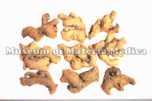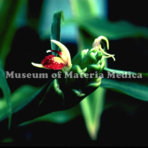Processed Ginger

|
Market name:乾姜 Photo location:Museum of Materia Medica, Inst. of Nat. Med. TMPW No.:16753 |

|
Plant name:Zingiber officinale Photo location:Toyama Pref., Japan Photo date:1983 Photographer:H. Fujino |
| Synonym | |
| Latin name | Zingiberis Rhizoma Processum |
| Botanical source: Family name | Zingiberaceae |
| Botanical source: Plant name | Zingiber officinale Roscoe (IPNI:798372-1) |
| Part used | Rhizome, after being passed through hot water. |
| Empirical criteria for quality selection | |
| Constituents | Other aliphatic and related compounds: Methylheptenone, Nonylaldehyde Monoterpenoids: β-Phellandrene, Camphene, Citral, Linalool, d-Borneol, Farnesene, α-Terpineol, Nerol, Sabinene, 1,8-Cineol, Myrcene Sesquiterpenoids: Zingiberol, α-Zingiberene, α-Bisabolene, β-Bisabolene, γ-Bisabolene, α-Curcumene, β-Curcumene, Zerumbone Other aromatic derivatives: Hexahydrocurcumine, Dihydrogingerol, Desmethylhexahydrocurcumine, Zingerone, Shogaol, [6]-Gingerol, [8]-Gingerol, [10]-Gingerol, Dehydrogingerone |
| Pharmacological effects | Supression of central nervous system ([6]-gingerol, [6]-shogaol). Analgesic ([6]-shogaol). Inhibition of prostaglandin synthesis ([6]-gingerol, [6]-dehydrogingerone). Spasmolytic (essential oil). Conduction anesthesia (water extract). Antitumor (water extract). Antiemetic (ginger juice). |
| Indications | It is applied to abdominal pain with cold feeling, lumbago and diarrhea. In chinese medicine, it is applied to treat cold in the interior synptom-complex. |
| Diseases | Pain due to abdominal coldness, Diarrhea, Vomitting, Coldness of limbs, Weak pulse, Cough, Dyspnea, A lot of sputum |
| Formulas | uzushakusekishiganryo , uyakujunkisan , orento , ompito , kaikyushokushoto , kankyooren'ogon'ninjinto , kankyoninjinhangegan , kankyobushito , kanzokankyoto , kanzoshashinto , kishukunichinto , kyukichoketsuin , kyukichoketsuindaiichikagen , kyutsugan , keishininjinto , kenchuto , goshakusan , saikokeishikankyoto , shigyakukaninjinto , shigyakuto , shishikankyoto , shokyoshashinto , shoseiryuto , shoseiryutokakyoninsekko , shoseiryutokasekko , shobaito , jinsoin , soshikokito , zokumeito , daikenchuto , daibofuto , chukenchuto , tsumyakushigyakukachotanjuto , tsumyakushigyakuto , tokato , tokito , ninjinto , hangeshashinto , hangebyakujutsutemmato , byakutsukachotanjuto , byakutsuto , bukuryoshigyakuto , bushirichuto , ryokankyomishingeninto , ryokyojutsukanto |
| Meridian tropism | Heart, Lung, Spleen, Stomach |
| Property | Extremely hot |
| Flavor | Extremely acrid/pungent |
| Classification in "Shen-non Ben-cao Jing" | Middle |
| TCM: Classification | Drugs for dispelling internal cold |
| TCM: Medicinal effects | To dispel cold from the spleen and the stomach, to promote recovery from collapse, relieve pain, and to eliminate damp and phlegm: For epigastric pain with cold feeling, vomiting and diarrhea accompanied by cold extremities and faint pulse, dyspnea and cough with copious frothy expectoration. |
| Remarks | Listed in the Japanese Pharmacopoeia 18th ed. Since ancient times, shengjiang, in Chinese Traditiona Medicine, has been representing fresh ginger, and ganjiang means dried one. That is, dried shengjiang (or ganshengjiang) in Chinese drug market indicates ganjiang in Kampo. Then ganjiang in the market means dried, after steamed, shengjiang. It can be called processed one. In China, in contrast, fresh ginger is shengjiang and dried one is ganjiang. In addition, there is Paojiang which is a processed medicine. Paojiang is made as follows. First of all, the clean sand (gefen, huashifen) should be into a pan and heated at strong fire. The dried unpeeled shengjiang is added in and mixed them until the surface swells and the color turns to brown. Then it is picked up and cooled in air. |
| References |
DNA sequences of medicinal plants
| Gene Region | |||||||||||||||||||
| Nuclear | Chloroplast | Mitochondria | |||||||||||||||||
| Botanical source: Plant name | 5Ss | 18S | ITS1 | 5.8S | ITS2 | 26S | others | trnH-psbA | matK | trnK | trnK-rps16 | trnT-L | trnL | trnL-F | rbcL | rpoC1 | ndhF | others | |
|
|
|||||||||||||||||||
